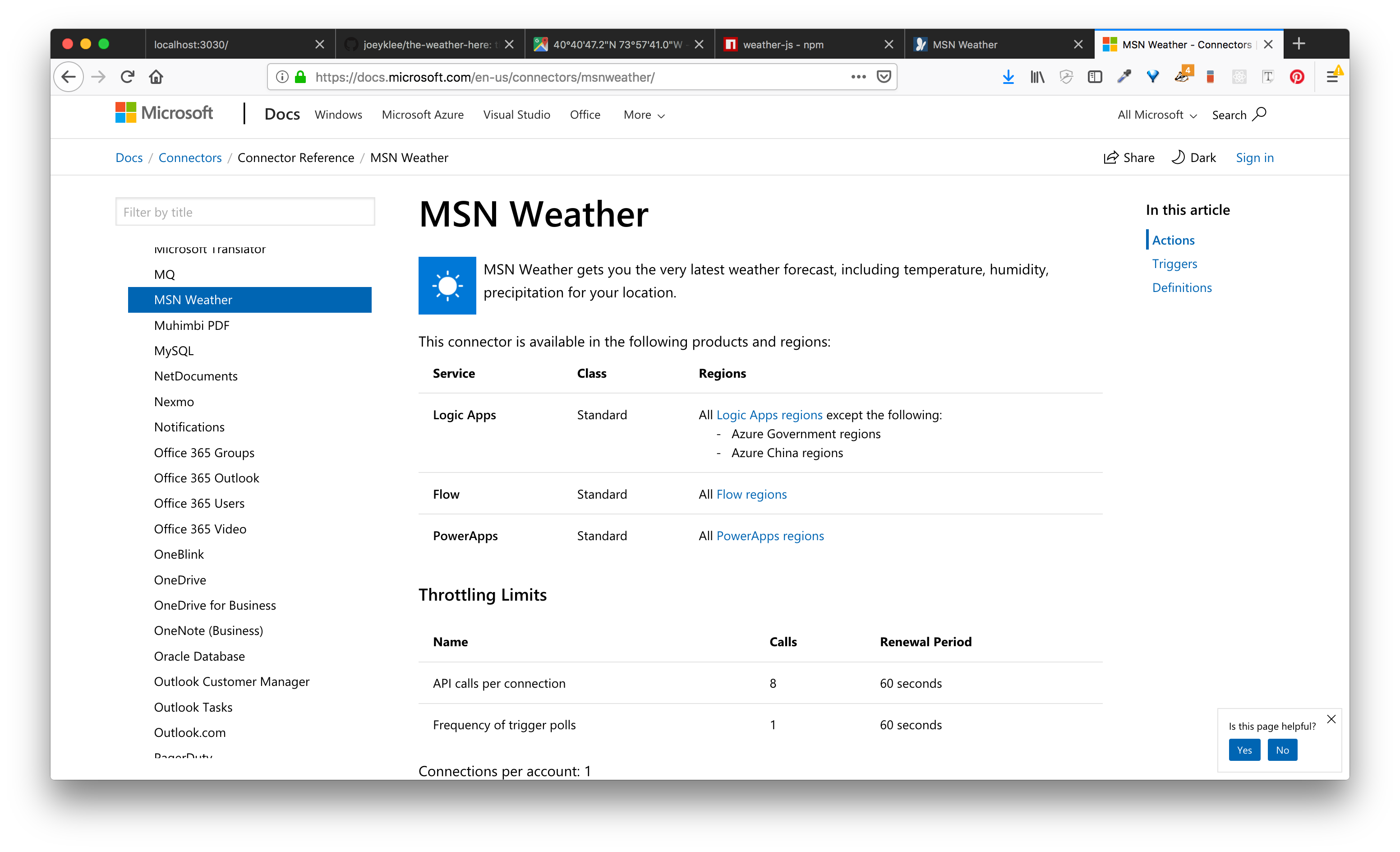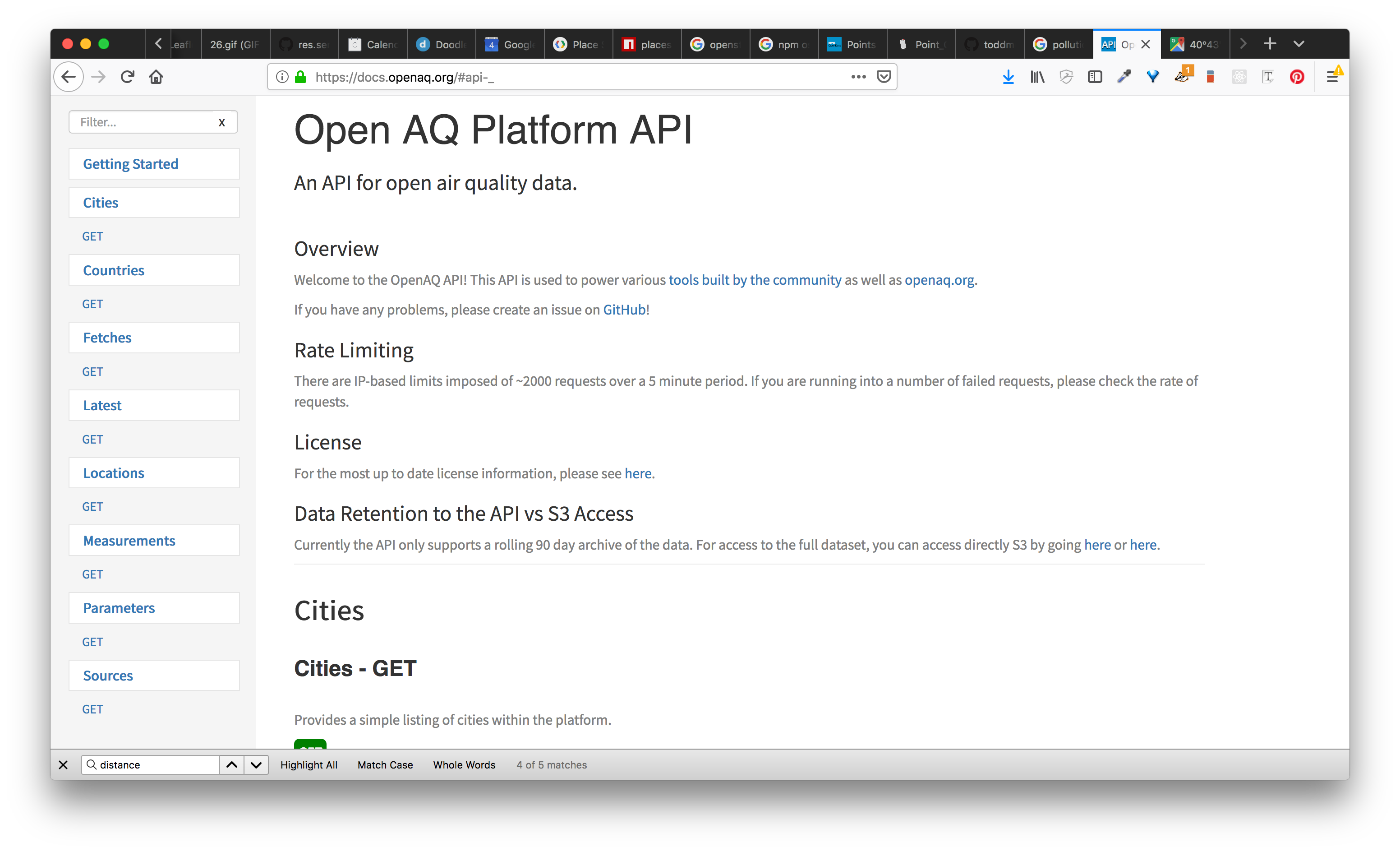This is a little application that prompts you to "check-in". This application gets your location data then retrieves the weather for that location. On the server, the server queries the OpenAQ - open air quality - database for pollution data within 10km of the given coordinates. You can view your checkins and also a little "story" writted from the contextual data collected from the application. This includes data on the weather, your location, and the pollution in that area if measurements are available.
cd the-weather-here
npm install
npm startthe app will be running at: http://localhost:3030
see: index.js
// allow us to use "fetch()" on the server
require('es6-promise').polyfill();
require('isomorphic-fetch');
// our 3rd party apis we want to query
const weather = require('weather-js');- es6-promise: allows us to use es6 promises
- isomorphic-fetch: allows us to use the
fetch()function on the server.fetch()is a function which is a built in browser function for making HTTP requests. For consistency, people have mirrored the functionality for serverside requests. - weather-js: a library to make it easier to query MSN's weather data API.
see: index.js
// Show submission page
app.get("/weather/:lat/:lng", (req, res) => {
let latlng = `${req.params.lat},${req.params.lng}`
let searchOptions = {
search: latlng,
degreeType: 'C'
}
weather.find(searchOptions, function(err, result) {
if(err) console.log(err);
console.log(JSON.stringify(result, null, 2));
// we get back an array, so we only send the first value
res.send(result[0]);
});
});- Here whenever people query the endpoint: `/weather/40.679770/-73.961384, then we can get the weather for the location that the person is querying from.
// accept a payload to this checkin post endpoint
app.post("/checkin", (req, res) => {
// our unix timestamp
const unixTimeCreated = new Date().getTime();
// add our unix time as a "created" property and add it to our request.body
// we receive the location data from the client in the req.body
const newData = Object.assign({"created": unixTimeCreated}, req.body)
// QUERY THE OPEN AQ PLATFORM FOR AIR QUALITY DATA
const searchDistance = 10000; // meters == 10km
let openAQUrl = `https://api.openaq.org/v1/latest?coordinates=${req.body.location.lat},${req.body.location.lon}&nearest=${searchDistance}`
fetch(openAQUrl)
.then(result =>{
return result.json();
}).then(result => {
// add the pollution data to our newData
// console.log(result)
newData.pollution = result;
// insert the data into our db
db.insert(newData, (err, docs) =>{
if(err){return err;}
res.send(docs);
});
}).catch(err => {
return err;
});
});- Here we accept a POST request. In our POST request, we get the location, and the weather data that was requested earlier.
- The cool thing here that we do is to get the air quality data based on the location that is sent from the client.
- You can see that we structure our query like so:
https://api.openaq.org/v1/latest?coordinates=${req.body.location.lat},${req.body.location.lon}&nearest=${searchDistance}where the%{}is a javascript template literal that allows us to mash up the result of javascript variables with text.
Using the leaflet.js library, we create a map of our checkins:
see: /public/checkin/sketch.js
// create a leaflet map instance and using the "map" id set in your index.html
myMap = L.map('map')
.setView([latestLocation.lat, latestLocation.lon], 10);
// add your openstreetmap layer to your myMap variable
const tiles = L.tileLayer('https://{s}.tile.openstreetmap.org/{z}/{x}/{y}.png', {
attribution: '© <a href="https://www.openstreetmap.org/copyright">OpenStreetMap</a> contributors'
});
tiles.addTo(myMap);
...
// for each item in myData, create a circle with a popup
for (let p in myData) {
let item = myData[p];
let location = item.location
let weather = item.weather;
let pollution = item.pollution;
// add a circle to the myMap variable
let currentCircle = L.circle([location.lat, location.lon], 700, {
color: "red"
}).addTo(myMap);
// add some popup text
let popUpText = `I'm sitting out here on this ${weather.current.skytext} ${weather.current.day} and it feels like ${weather.current.feelslike}℃ outside.`;
if(pollution){
popUpText += `\nThe concentration of small carcinogenic particles (pm2.5) I'm breathing in is ${pollution.results[0].measurements[0].value}${pollution.results[0].measurements[0].unit}`
popUpText += `\nmeasured from ${pollution.results[0].city} at ${pollution.results[0].location}.`
}
currentCircle.bindPopup(popUpText)
}- this snippet adds a leafletjs map to the
<main id="map>tag on out/public/index.html - the second part of the code renders each point you checked in point to the map. The
L.circle()function creates a point and the.addTo(myMap)function adds it to the map that we calledmyMap. - if we have pollution data, we add that to the popup that shows on click.




